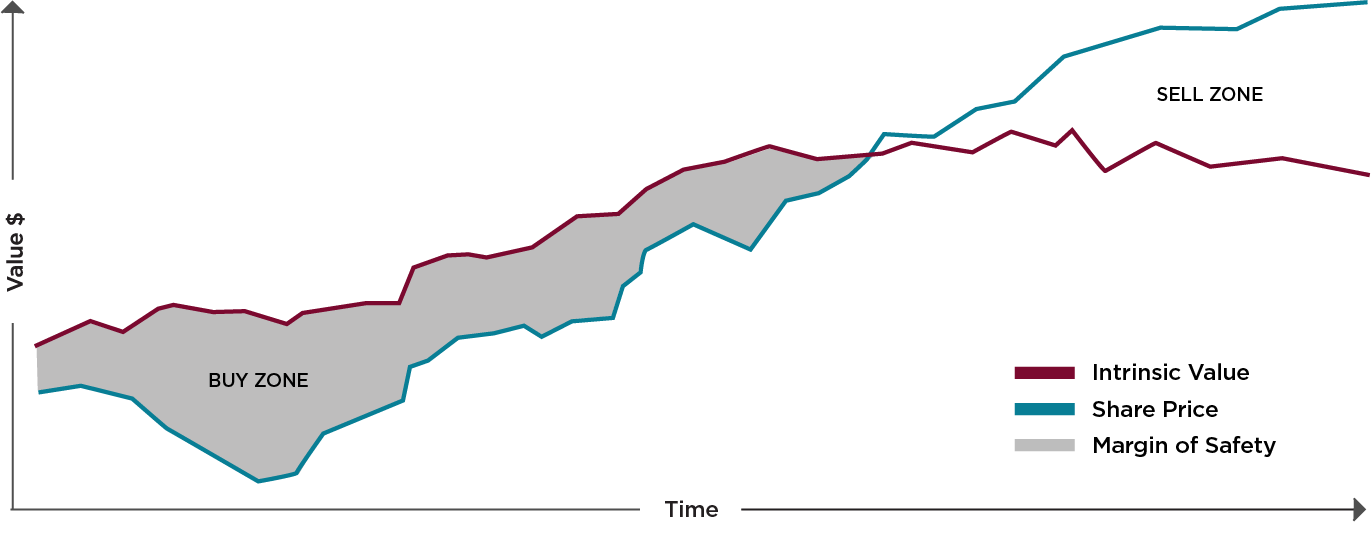Markets are unpredictable. We’re not.
When the path ahead is anything but clear, it helps to have something steady to rely on. At Burgundy, we believe in adhering to a disciplined approach that won’t waver when the ground starts to shift. In this updated edition of “Margin of Safety”, originally written nearly 25 years ago, we revisit the core principles behind our investment process: invest in high-quality companies, buy them at a discount, and hold with conviction. It’s a straightforward approach—but far from easy. Here’s why it works.
HIGHLIGHTS:
- Quality and value come first: We invest in high-quality companies with strong fundamentals, capable management, and long-term growth potential—but only when the price is right.
- Margin of safety matters: We believe in preparing for the future, not trying to predict it. Buying below intrinsic value is like having a safety net for uncertainty.
- Strong leadership is more than just financial results: When assessing management, we look for transparency, thoughtful capital allocation, and alignment with shareholders.
- Standing apart from the crowd is part of the process: Outperformance often involves going against the grain, which is why we prefer long-term conviction over short-term trends—even if that means weathering periods of underperformance.
“In the old legend the wise men finally boiled down the history of mortal affairs into the single phrase, “This too will pass.” Confronted with a like challenge to distill the secret of sound investment into three words, we venture the motto, MARGIN OF SAFETY.”—Benjamin Graham, Chapter 20, The Intelligent Investor (1949)
At first glance, Burgundy’s quality/value investment approach seems straightforward: Invest in well-managed, high-quality companies, purchase them for less than they are worth, and hold them for the long run. Simple? Yes. Easy? Not quite. To fully understand how our investment approach works, it’s important to revisit our guiding principles—how we assess a company’s quality, decide how much we are willing to pay, and build a high-conviction portfolio. By breaking down each aspect, we separate theory from practice and reinforce one of Burgundy’s core concepts: margin of safety.
IDENTIFYING HIGH-QUALITY COMPANIES
From the dot-com bubble in 2000 to the global financial crisis in 2008 and the pandemic crash in 2020, history shows that a company’s quality and earnings matter during economic crises and periods of market volatility. At Burgundy, we have always been selective about the investments we make, recognizing that buying high-quality companies is essential to preserving and growing capital.
We look for companies with:
- Strong barriers to entry and competitive advantages
- Products or services that customers value
- Capable and honest management
- The potential to grow free cash flow over the long term
- Manageable levels of debt
Companies with these characteristics have greater control over their destiny. Their competitive advantage leads to a strong market position, often resulting in higher returns on equity and significant free cash flow. However, accounting earnings alone do not provide a complete picture of a company’s financial health, including how easily it can meet its debt obligations and fund growth. The balance sheet also won’t reveal risk factors such as regulatory changes, shifts in leadership, and new competition. For example, in 2023, both the Silicon Valley Bank (U.S. regional bank) and Evergrande (China’s largest real estate developer) collapsed. Simply looking at the financial statements of these companies would not have revealed their liquidity problems.
For Burgundy to invest, these companies must generate cash that can either be reinvested into the business or returned to shareholders through dividends or share buybacks.
WHAT TO LOOK FOR IN A STRONG MANAGEMENT TEAM
One of the most important aspects of a high-quality company—and one of the most difficult to assess—is its management. When evaluating a management team, we focus on their operational skills (how well they run the business) and their approach to capital allocation (how and where they spend money). While we review metrics like operating profit margins, returns on capital, and industry-specific indicators, we also look at the intangible qualities that make great executives great. Are they passionate about their business? Are they obsessed with operational efficiency? Do they thrive on outperforming the competition? Are they motivated to win?
How well management allocates capital is key to our analysis. Companies with significant free cash flow beyond maintenance capital expenditures are at risk of making poor decisions simply because they have extra capital to deploy. As minority shareholders, we have little control over these decisions, which lie with top management. We fear that CEOs might waste cash on frivolous spending, such as extravagant headquarters, or, worse, acquiring unrelated, inferior businesses.
Equally important to capital allocation is management’s candour with shareholders like Burgundy, as we rely on transparency to understand the business and its environment. Since public shareholders are minority owners, insiders should be sufficiently transparent to help shareholders understand the company and the environment in which it operates. Management builds credibility by avoiding surprises and addressing potential negative outcomes while explaining how the company plans to respond. CEOs who openly discuss business risks often have a clearer idea of how to address them. In our experience, while mistakes are inevitable, the ability to acknowledge, analyze, and learn from them separates the good leaders from the bad ones.
Warren Buffett perfectly encapsulates our views on the importance of straight talk in the following statement: “The CEO who misleads others in public may eventually mislead himself in private.” It is shocking how often we find this to be the case.
Engaging in conversations with CEOs and management teams provides insight into a company’s vision and strategic direction and helps determine whether a company is managed for short-term investor demands or the long-term interests of committed stakeholders, including Burgundy and our clients. We also stress-test our findings. By leveraging our network of industry experts, customers, and competitors—along with decades of experience—we combine quantitative research with human judgment to gain a well-rounded perspective on a company.
BUY AT A DISCOUNT
Although there may be times when shares of companies with elevated valuations continue to rise, history shows that, over the long term, valuations are driven by earnings growth, reinforcing the notion that valuations matter.
When estimating a company’s true worth, or its intrinsic value, we consider:
- the cash flows an asset generates,
- the rate at which these cash flows grow, and
- the discount rate applied to them.
Getting more than you paid for is fundamental to the value portion of our quality/value investment approach. In other words, price is what you pay, and value is what you get.
Before we invest, we ensure that a company’s share price is trading at a discount to our estimate of its intrinsic value, thereby providing a margin of safety. Since forecasting the future with absolute certainty is impossible, we are sensitive to the price we pay. This cushion between the price paid and our estimate of the asset’s true value provides a margin of safety against any unforeseen negative events. If a company meets our quality criteria but not our valuation assessment, it goes onto our Dream Team list for further monitoring.

We continually evaluate our portfolio companies to ensure our assessments of their quality and value remain intact. However, we will consider selling our investment if:
- a company’s share price becomes excessively overvalued;
- there is a permanent deterioration in the company’s fundamentals or management; or
- we find a better investment opportunity.
STANDING APART FROM THE CROWD
Buying companies at a discount means our performance will sometimes differ from the broader market or other investors. To generate strong, differentiated returns over the long run, we must be willing to stand apart from the crowd. Whether by avoiding herd mentality during short-term market fluctuations or focusing on opportunities others may overlook or, we believe, misunderstand, we take a disciplined, independent approach to achieving strong long-term results.
From resisting the rush into commodities to maintaining caution on high-flying technology stocks or investing in underappreciated regions like Japan, we believe our balanced approach—grounded in both quality and value—provides the best path for long-term capital preservation and growth.
INVESTING WITH CONVICTION
At Burgundy, we think investing in a select group of high-quality businesses is the best way to achieve long-term results for our clients. By focusing on deep research, we gain an intimate understanding of each business and its management—taking a different approach than many broad investment portfolios or exchange-traded funds. As we’ve touched on, our Investment Team is highly selective, focusing on companies that meet Burgundy’s quality/value criteria and will compound capital for our clients over time. This disciplined approach prioritizes quality over quantity, ensuring we invest in businesses with strong fundamentals and long-term growth potential. With appropriate diversification across sectors and countries, our portfolios are designed to thoughtfully preserve and grow capital while maintaining a concentrated, high-conviction approach.
THE EIGHTH WONDER OF THE WORLD
Albert Einstein called compounding the “eighth wonder of the world,” and we agree—especially when you include a long-term outlook. By consistently investing in high-quality companies and letting time work its magic, our clients have experienced the power of compounding. However, since meaningful results take time and often come with periods of discomfort, executing this strategy successfully demands patience.
CONCLUSION
For over 30 years, Burgundy has focused on preserving and growing our clients’ capital by applying a disciplined investment approach that insists on both quality and value.
Invest only when a significant discount to intrinsic value exists. Invest in high-quality businesses run by capable, honest, shareholder-minded managers. By carefully applying these “first principles,” we strive for a “margin of safety” in every investment that we make. As quality/value investors, we believe this approach to investing preserves capital and generates strong long-term investment results.
Subscribe to Views & Insights
Original date of publication is February 2001. This article was updated in April 2025.
DISCLAIMERS
This post is presented for illustrative and discussion purposes only. It is not intended to provide investment advice and does not consider unique objectives, constraints or financial needs. Under no circumstances does this post suggest that you should time the market in any way or make investment decisions based on the content. Select securities may be used as examples to illustrate Burgundy’s investment philosophy. Burgundy funds or portfolios may or may not hold such securities for the whole demonstrated period. Investors are advised that their investments are not guaranteed, their values change frequently and past performance may not be repeated. This post is not intended as an offer to invest in any investment strategy presented by Burgundy. The information contained in this post is the opinion of Burgundy Asset Management and/or its employees as of the date of the post and is subject to change without notice. Please refer to the Legal section of this website for additional information.

